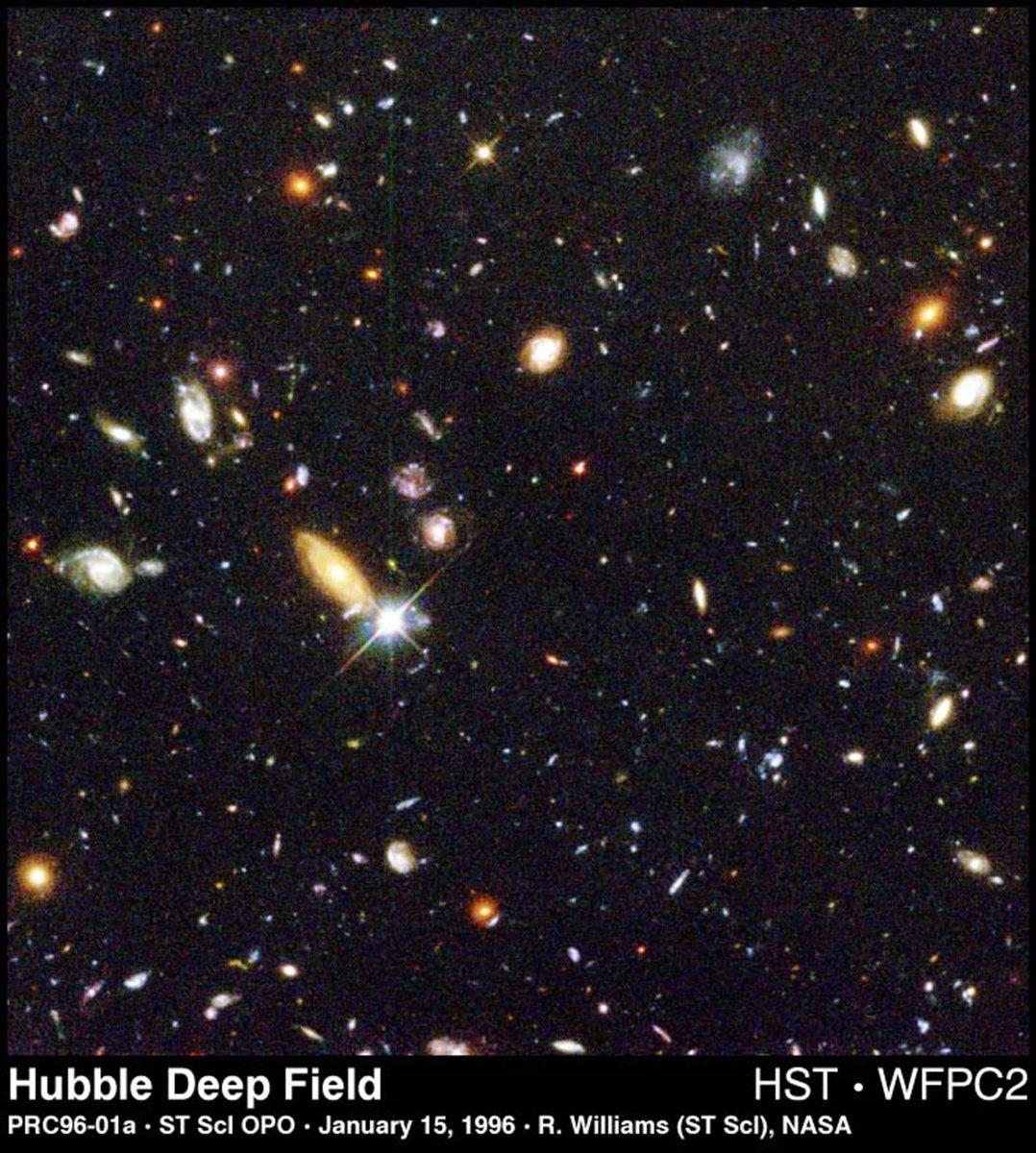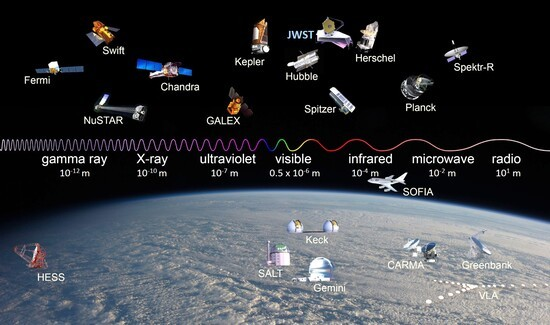
While we wait 6 months for #JWST to get ready, let's explore what sorts of images and data we can expect from JWST.
We are all used to seeing Hubble's dazzling images of galaxies and nebulae. Will JWST's images look like these?
1/
We are all used to seeing Hubble's dazzling images of galaxies and nebulae. Will JWST's images look like these?
1/

Hubble primarily observes in the UV and visible light wavelengths from 0.1-0.8 μm but it can also see parts of the infrared (IR) spectrum from 0.6-2.5 μm.
Visible light images can produce the colorful ghostly images of nebulae but IR can reveal more distant stars and galaxies.
2/
Visible light images can produce the colorful ghostly images of nebulae but IR can reveal more distant stars and galaxies.
2/

Can we can expect #JWST images to be similar to those on the right above? JWST observes in the orange to mid-infrared wavelengths from 0.6-28.3 μm.
JWST’s NIRCam and NIRSpec instruments cover 0.6 to 5 μm, the MIRI ultra-cold instrument covers 5 to 27 μm
Can JWST see farther?
3/
JWST’s NIRCam and NIRSpec instruments cover 0.6 to 5 μm, the MIRI ultra-cold instrument covers 5 to 27 μm
Can JWST see farther?
3/
Hubble, with its IR detectors, can observe stars and galaxies as far back as a few 100 million years after the Big Bang. Light from that era has taken over 13 billion years to arrive, its wavelengths have been stretched out to IR, by the expansion of space and the Universe.
4/
4/

JWST, with its infrared capability and large mirrors, will be able to observe objects all the way to about 100M to 250M (0.1B to 0.25B) years after the Big Bang.
5/
5/
What happened after the Big Bang?
For the first few 100K years, the Universe was filled with protons, neutrons, and electrons free from each other. Any photons would get scattered by the electrons, making that period dark and opaque.
6/
For the first few 100K years, the Universe was filled with protons, neutrons, and electrons free from each other. Any photons would get scattered by the electrons, making that period dark and opaque.
6/
As the Universe cooled down, 240K to 300K years after the Big Bang, in a process called "Recombination", protons, neutrons and electrons combined into atoms of hydrogen and deuterium. Light could now travel far distances but there were no strong sources of light like stars.
7/
7/
This “Dark Age” ended around 300M years after the Big Bang, as atoms clumped into stars. It was a violent universe, where some stars exploded into Supernova while heavier elements, more stars, galaxies, and black holes were formed.
8/
8/
JWST will uniquely be able to explore this space-time of the Universe, 100M to 250M (0.1B to 0.25B) years after the Big Bang (as well as other regions closer to earth)
9/
9/

Hubble took this famous image of nearly 1,500 galaxies called the Hubble Deep Field (HDF) in Dec 1995, in UV, visible light and near-IR wavelengths (0.12-1.0 µm), showing some galaxies that existed nearly 1 billion years after the Big Bang.
hubblesite.org/contents/media…
10/
hubblesite.org/contents/media…
10/

The HDF was an awe-inspiring image which prompted scientists to look further back in time.
This next image was taken in IR wavelengths 1.0-1.6 µm in 2009 using the newly installed Hubble Wide Field Camera 3 (WFC3). It captured objects within a few 100M years of the Big Bang.
11/
This next image was taken in IR wavelengths 1.0-1.6 µm in 2009 using the newly installed Hubble Wide Field Camera 3 (WFC3). It captured objects within a few 100M years of the Big Bang.
11/

The above images are composites of multiple images taken over extended periods of time at different spectrum bands (using filters). The images were assigned colors depending on the band.
12/
12/
These images are what we think JWST images will look like, all imaged and colored in various IR wavelengths, but peering deeper in time, to within 100M to 250M years after the Big Bang!
13/
13/
Note that larger IR wavelengths means lower resolution as explained by Mark below. JWST’s resolution at the lower IR wavelengths will be similar to that of Hubble at visible, but with the larger mirror, JWST will be able to detect much fainter objects.
14/
14/
https://twitter.com/markmccaughrean/status/1479831824654389255
Of course, lot more data will be collected than what is shown in such images. Spectroscopic analysis by JWST’s sophisticated instruments will help identify the chemical composition of stars and help improve our understanding of the physics of stars, galaxies and black holes.
15/
15/
JWST will also study younger galaxies, their components and the processes that drive their evolution. Similarly, #JWST will help detect exoplanets and use spectroscopic analysis to identify their chemical composition and search for signatures of life.
16/
16/
Here are some dazzling images of galaxies and nebulae closer to earth taken by the Spitzer Space Telescope, 2003-2020, observed in the IR 3.6-160 µm wavelength range. We can perhaps expect similar images from JWST as well.
17/
spitzer.caltech.edu/news/feature15…
17/
spitzer.caltech.edu/news/feature15…

This #JWST thread is aimed at a wide audience, so it errs on the side of oversimplification.
I am not an astrophysicist, so hopefully some of you who are, will correct any errors in this explanation.
To explore further, please check out jwst.nasa.gov/content/scienc…
18/
I am not an astrophysicist, so hopefully some of you who are, will correct any errors in this explanation.
To explore further, please check out jwst.nasa.gov/content/scienc…
18/
A note on JWST resolution.
The smallest angle a telescope can resolve
θ = 210000 * λ / D, in arcseconds (1/3600 of a degree)
where λ is the wavelength and D the mirror diameter.
Shorter wavelength means better resolution.
Larger mirror gives better resolution.
The smallest angle a telescope can resolve
θ = 210000 * λ / D, in arcseconds (1/3600 of a degree)
where λ is the wavelength and D the mirror diameter.
Shorter wavelength means better resolution.
Larger mirror gives better resolution.
Hubble diameter = 2.4m, wavelength = 0.1-0.8 μm, JWST diameter = 6.5m, wavelength = 0.6-5.0 and 5.0-28.3 μm.
Lets compare resolution of a Hubble image at 0.6 μm vs JWST at 3 μm.
Hubble θ = 0.052 arcsec
JWST θ = 0.096 arcsec
Hubble has better resolution at 0.6 μm than JWST at 3 μm
Lets compare resolution of a Hubble image at 0.6 μm vs JWST at 3 μm.
Hubble θ = 0.052 arcsec
JWST θ = 0.096 arcsec
Hubble has better resolution at 0.6 μm than JWST at 3 μm
At longer wavelengths, JWST's resolution is even lower.
But the larger mirror enables fainter objects to be imaged. Besides, Hubble cannot observe at these infrared wavelengths.
But the larger mirror enables fainter objects to be imaged. Besides, Hubble cannot observe at these infrared wavelengths.
Also, JWST's field of view and detector sizes (# of pixels) are larger, allowing it to scan a much larger section of the sky more quickly.
The Hubble Deep Field image captured about one 24-millionth of the whole sky, 2.6 arcminutes side-to-side, after several days of imaging.
The Hubble Deep Field image captured about one 24-millionth of the whole sky, 2.6 arcminutes side-to-side, after several days of imaging.
• • •
Missing some Tweet in this thread? You can try to
force a refresh










